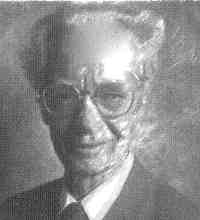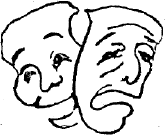


by Edward G. Rozycki, Ed. D.
RETURN
edited 2/7/19
If it flies like a duck, walks like a duck and quacks like a duck, then it's a duck -- Proverb
Likeness is Not Identity
Human beings tend to perceive likenesses all over the place: a cloud that looks like a dog, ancient wind bells that sound like they're chiming a popular song, an apple that smells like a rose, coffee that tastes like chocolate, woven cloth that feels like fur. This propensity is called Pareidolia. It is normal and useful and part of how we educate children, e.g. by playing a game called, "What is like a ____, but much bigger?" or "How is a ballerina like a (kind of bird)?"
But it is also not unusual for people to jump to the conclusion that if X looks, sounds, smells, tastes or feels like Y then X is (an example of) Y. "Harry looked over at me with an angry face," becomes "Harry was angry with me." A distant rumble that could be drums is taken for thunder. This is to say that humans often take some comparison of structures to be an isomorphism on the basis of partial parallels of between the two structures (homomorphism).
In some cultures this psychological bent is exploited by people who read tea leaves, Tarot cards, chicken bones and palms, believing them to relate to greater structures of events in the world. But similar things are done by medical diagnosticians who check eyes, ears, skin, heart beat, nose and throat for patterns of abnormalcy that can be correlated with physical symptoms (structures) of disease. It all depends on the theoretical backup whether we accept the Pareidolia as superstition or as scientific diagnosis.
In the chart below you can see things which are partially isomorphic (homomorphic) to other structures you have experienced.

|

|
A YouTube video. |

|
|
a.
This is not B. F. Skinner
|
b.
These are not human faces.
|
c.
This is a sample from the U.S. National Anthem.
|
d.
This is a tiny reproduction of a Klee Painting
|
Chart 1
Which of the subtitles in Chart 1 is correct? Answers: a., b. and d. are true. But c. is false. How so?
To begin:
a. is a picture of B. F. Skinner, not the man himself. (A trick question?)
Similarly, b. is a symbol representing Drama; it contains parts which are structured somewhat like a human face. However, those parts are not human faces.
c. is a piece of a tune, but the tune is Gaudeamus Igitur, a Latin academic song of celebration.
d. is what the subtitle says it is.
You might find these "right" answers somewhat annoying because they invoke contexts which were not specifically mentioned. You just went ahead and assumed the "usual" contexts of identification, to wit:
1. Consider example a. When you are shown a picture of someone and asked to identify it, you don't imagine that the comparison is with the person whose picture it is, but rather with pictures of other people. Thus, you don't have to mention its being a picture. [1]
2. Consider example b. Picky, picky, picky! The"normal" assumption here is that "not human faces" is meant to contrast with "animal faces," or "Martian faces" or "the faces of Greek Gods," etc. What we don't expect is that the use of the symbol of Drama is the issue.
3. Consider example c. No trick. Context obvious and pertinent. Music is recognized by how it sounds, even if the instrumentation is weird or distorted. It is clearly not the U.S. National Anthem.
4. Consider example d. How it looks and how it has been distorted has been taken into account and makes it a relatively straight-forward identification, if you are familiar with Klee.
Can Any Two Things Be Understood as Be Alike? Even, Isomorphic?
It seems that if you're willing to overlook differences, any two things can be considered to be the same.
Consider your Uncle Charlie. Consider also a basketball. There are many ways in which they differ. Disregard these differences. Notice these similarities (Not just any will do; you have to be selective):
1. Your Uncle Charlie has a covering, his skin. So does the basketball, even though it is of a different material.
2. Uncle Charlie's skin separates his insides from his outsides. The basketball's skin does the same for the basketball.
Uncle Charlie and the basketball can be considered, in the abstract, each to consist of a three part structure:
A. an enveloping neighboring space[2] three inches or less from
B. a covering "skin"; and
C. an internal space.
For both Charlie and the basketball, A. contains B. contains C.
Thus, Uncle Charlie and the basketball are isometric:
3. their structures have three parts: for Charlie, AC, BC and CC; for the basketball AB, BB, and CB;
4. The parts of Uncle Charlie correspond to the parts of the basketball in a one-to-one relationship;
5. Charlie's parts relate to one another in the same way as do the parts of the basketball; and
6. the relational terms for Charlie's parts, "contains," maps into those of the basketball in a one-to-one relationship.
An interesting relationship,
perhaps, if you think how it would work to compare people you know with
a jackass, but aside from bringing some levity to a social gathering, is
it really all that useful? Does it give us insight? Does it warm the
coffee?
Isomorphisms Everywhere; But Also Mistakes To Be Made
With a little imagination in using common classifiers and disregarding differences, we can find isomorphisms all over the place. Comparing a cow and a man is clearly easy. What often proves productive in such an exercise is not what common structure we find, but what items we disregard to construct the isomorphism, e.g. the dissimilarities in stomach structure.
But the important point is this. Even bizarre pairs of objects can be understood to be isomorphic as some level of abstraction. We can create isomorphisms we can't normally recognize. (See footnote 1)
For example, consider Beethoven's Fifth Symphony and a hotdog in a bun. What are the structural elements both share that stand in the same or corresponding relationships to each other in each of the two structures? They might be listed as beginning, end, ingredients, stage of consumption, relative contribution of parts to the enjoyment of the whole.
Let's chart these up:
| Shared Terms | Fifth Symphony Elements | Fifth Symphony Relations | Hotdog in Bun Elements | Hotdog Relations |
| beginning (B) | first five bars | precedes | first bite | precedes |
| end (E) | last five bars | follows | last swallow | follows |
| ingredients (I) | main theme, other themes | contains, precedes, outlasts, concurrent | hotdog, relish, mustard, ketchup | contains, together, outlasts, spread over |
| stage of consumption (C) | first, second.... movements | precedes, follows | first, second ....quarter (eighth) | precedes, follows |
| contribution to enjoyment (J) | low to high interest, surprise, beauty, sad, inspiring | enhances, conflicts with | tang, hotness, juiciness, sweetness | enhances, conflicts with |
Chart 2
Can we select some of the shared terms to build a structure common to both the symphony and the hotdog? There's no need to use everything. Also, we want to be sure that the relationships between the elements map into each structure on a one-to-one basis. [3] (The process of checking out whether we can construct an isomorphism with these components is somewhat detailed and will be done later.)
Why Bother About Something So Ubiquitous?
If pareidolia is a natural propensity of humans why get so fired up about isomorphism? Precisely! It's only critical when we think we have an isomorphism that matters, e.g. that gives us insight into a problem. Suppose, for example, we have two processes or programs which take more or less the same inputs and yield more or less the same outputs. Need they share an isomorphism?
For example, if we were to compare the way a patient with occlusive arterial thrombosis were given treatment in a German hospital with the way a similar patient with similar symptoms were treated in an American hospital, supposing that initial conditions and treatment outcomes were the same, would this indicate that the German procedure and the American could be found to be isomorphic?
If we were to consider a variety of treatment programs in a variety of disciplines around the world and were to match up those with input-outcome identities (or similarities, to be more realistic), might find the following relationship between treatment success and program isomorphism:
Success &
Isomorphism; Success & No Isomorphism.
Failure & Isomorphism; Failure and No Isomorphism.
What is bothersome here is to think that there might be success and no isomorphism. Our first inclination would be to suppose that there really is a hidden isomorphism, that one program had accreted ritualistic or otherwise no-causal steps that masked the essential common structure. Aboriginal peoples may have insisted on a song and dance before burying a fish underneath a corn plant. We can just go straight ahead and bury the fish (or apply fertilizer) to get taller corn. There is an isomorphism here.
But not everything works that way. Let's consider a thought experiment[4] using matchsticks to double an integer. In this document they will be represented by a vertical slash, |.The programs we will compare will take an integer input, represented by a series of |'s and give an output with a double number of |'s.[5]
Program A:
1. Instruction: write down an arbitrary integer as a series of |'s. Intermediate Output #1: |||
2. Instruction: immediately adjacent right to the previous output, write step 1's output . Intermediate Output #2: ||||||
3. Finished.
Program B:
Comments:
A. This program will appear to many a reader as much less familiar. Its input is an integer represented by vertical slashes bounded at both ends by B. So 0 is BB, 1is B|B, 2 is B||B, 3 is B|||B, and so on. Outputs will be in the form E...E containing double the number of slashes we started out with.
B. The programs instructions are given as replacement rules. Each rule has a left part and a right part separated by an em-dash, —. If a formula contains anything in the form of the left part of the rule, the rule permits a substitution of that thing in the form of the right part. So X|X — E|X| indicates that B|X|X| should be rewritten as B|E|X||. The same rule is reapplied to its output so long as the appropriate form is available.
Let's use the integer 3, preparing it for treatment by rewriting it B|||B
Steps
1. Special Instruction: BB—EE, in case the integer chosen is zero, BB.
But we are working with B|||B.
2. Instruction: B|—EX|. Intermediate Output #1: EX|||B
3. Instruction: REAPPLY Instruction: X|—||X. Intermediate Output #2B: E||||X|B. Intermediate Output #2A: E||X||B
REAPPLY Instruction 3 : X|—||X. Intermediate Output #2B: E||||X|B
REAPPLY Instruction 3 : X|—||X. Intermediate Output #2C: E|||||||XB
4. Instruction: XB—E . Intermediate Output #3 : E||||||E
5. Finished.
It is clear that instruction 3 is the critical one. If it were written X|—|||X, it would triple the integer.
One might argue that the B's and E's are merely separators, or dividers. That there is "really" a hidden isomorphism to be exhumed. But these "mere" separators are functionally active in the process. The rules require them and they require the rules or something like them. They are not dispensible parts. Perhaps some kind of covering terms could be developed with which to identify structures to demonstrate an isomorphism beween the two programs. More likely they are just different ways to handle the same kind of problem, just as there might be two very different kinds of medical treatment to deal with the same ailment.
But perhaps it is just a matter of imagination and insight, just like seeing an isomorphic relation between Uncle Charlie and the basketball.
1. This plays on ambiguities between what we recognize and what we identify. See "Contrasting 'identify' and 'recognize' (Interesting ambiguities)."
2. Those who investigate Proxemics, the study of social interaction spacing, might call this "the innermost personal space."
[3] For a possible solution, see Addendum to Part B, Why Mistakes Are Interesting. (forthcoming)
[4] A thought experiment investigates what is conceivably possible, not necessarily what is likely or normal.
[5] See Martin Davis, Recursive Function Theory, pp. 89 - 95 in The Encyclopedia of Philosophy, Vol. 7 - 8, Collier-Macmillan. 1967. Paul Edwards (ed.) New York and London.
|
Related Paper: |